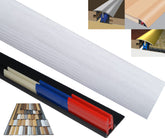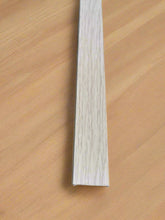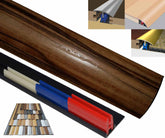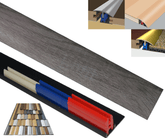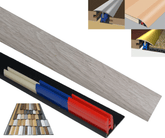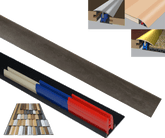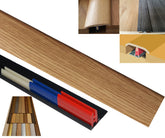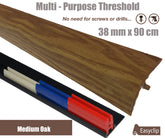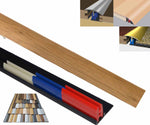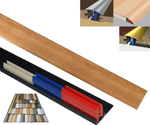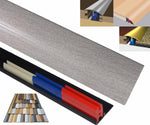How to Fit Different Fire Door Seals Following BS 476-P22 Guidelines
Why Fire Door Seals Are Essential – BS 476-22 Explained
BS 476-22 is the gold standard for fire resistance testing of doors, ensuring they perform under extreme conditions. A key takeaway from this British Standard is the critical role fire door seals play in saving lives. Intumescent seals expand when exposed to heat, sealing gaps to block smoke and flames. Without them, even a certified fire door may fail prematurely. Following BS 476-22 guidelines ensures proper seal placement and testing, making sure your fire doors meet legal and safety requirements. Ignoring this crucial step puts property and lives at serious risk. Always refer to BS 476-P22 when fitting fire doors and seals—compliance isn’t just smart, it’s potentially life-saving.
Here's a step-by-step guide to fitting BS 476-P22 compliant fire and smoke seals to door frames and doors. These seals are vital for maintaining the fire integrity and smoke control required under BS 476-P22.
🔧 Tools & Materials You May Need When the Door Or Frame is Not Pre Routed:
BS 476-P22 compliant fire and smoke seals (typically intumescent)
- Measuring tape
- Pencil
- Router or chisel
- Screwdriver or drill (if required)
- Sealant (if recommended by manufacturer)
- Safety goggles & gloves
![]() Step-by-Step Guide
Step-by-Step Guide
- Check Door & Frame Suitability
Ensure the door and frame are: Fire-rated (to the required minutes, e.g. FD30/FD60) In good condition with no warps, gaps, or damage
2. Measure the Seal Rebate
Measure the width and depth of the intumescent seal strip.
Standard seals are typically 10mm wide and 4mm deep, but always confirm with your product spec.
3. Mark the Rebate Position
Mark the position where the seal will be fitted—this is typically on the door frame head and both vertical jambs.
Some doors require fitting on the door leaf – follow manufacturer’s instructions.
4. Cut the Rebate
Using a router or sharp chisel, cut a straight, clean rebate along the marked lines.
Ensure consistent depth and width along the length for a snug seal fit.
5. Clean the Rebate
Vacuum or brush away all debris and dust.
Wipe with a clean cloth to ensure the adhesive will bond correctly.
6. Fit the Seal
If the seal is self-adhesive, peel off the backing and firmly press into the rebate.
If it requires mechanical fixing, screw or pin it in place per manufacturer guidance.
7. Check for Obstructions
Ensure the door closes freely with no resistance from the seal.
Check for uniform contact along the frame to maintain a smoke-tight fit.
8. Test the Fit
Close the door and check:
No visible gaps around the seal.
Door latches and locks operate normally.
The seal doesn’t impede closure or cause binding.
9. Apply Sealant (if required)
Some seals may require fire-rated sealant at ends or joins—follow the product’s instructions.
10. Label & Record
Label the door as fire-rated.
Record the installation date and seal type for compliance/audit purposes.
✅ Final Tip: Always follow the fire seal manufacturer’s instructions and ensure compliance with BS 476-P22 and any local fire regulations.
🔥 Fitting a Retrofit Fire & Smoke Seal (BS 476-P22)
🛠️ Tools & Materials Needed
- BS 476-P22 compliant retrofit fire & smoke seal
- Measuring tape
- Pencil or marker
- Fine-tooth saw or cutter (if needed)
- Screwdriver or drill (for mechanical fixings)
- Cleaning cloth
- Fire-rated sealant (if specified)
- Safety gloves and goggles
![]() Step-by-Step Instructions
Step-by-Step Instructions
- Confirm Door & Frame Suitability
Ensure the door is solid core and has sufficient clearances (typically 3–4mm gaps around the perimeter).Check for a fire certification label or confirm it's a fire-rated door (e.g. FD30 or FD60).
2. Choose the Right Seal
Use a BS 476-P22 compliant intumescent seal with smoke brush (if required).
Retrofit seals come in surface-mounted or clip-in designs—select based on your door frame setup.
3. Measure & Cut the Seal
Measure the head and both jambs of the door frame (or the door leaf, if specified).
Cut the seal to size using a fine-tooth saw or snips, ensuring a tight, continuous fit with no gaps at corners.
4. Clean the Surface
Wipe down the area where the seal will be applied to remove dust, grease, or old adhesive.
For self-adhesive seals, this step is crucial for strong bonding.
5. Apply the Seal
➤ Self-Adhesive Seals:
Peel off the backing strip and carefully press the seal into place along the frame or door edge.
Apply firm pressure along the length to ensure full adhesion.
➤ Mechanically Fixed Seals:
Align the seal and use the supplied screws or pins to fix in place.
Do not overtighten, as it may damage the seal or compress the intumescent material.
6. Check for Proper Seal Contact
Close the door and check:
There is slight resistance from the brush/smoke seal (not excessive).
The door still closes fully and freely.
There are no visible gaps between the door and frame.
7. Apply Sealant (if required)
If joints or ends need sealing, use a fire-rated mastic or sealant as per the manufacturer’s guidelines.
8. Test & Inspect
Conduct a functional check: ensure proper sealing, door operation, and no obstruction of latches or hinges.
Look for consistent contact between the seal and door edges.
9. Label and Document
If this is part of a fire door upgrade, label the door (e.g., FD30/FD60 retrofit seal fitted).
Keep records for inspection, certification, or fire safety audits.
✅ Important: Always follow the manufacturer’s instructions and check for local fire safety regulations in addition to BS 476-P22.


